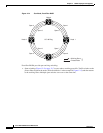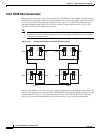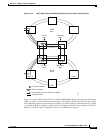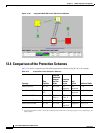
12-13
Cisco ONS 15454 Reference Manual, R7.0
78-17191-01
Chapter 12 SONET Topologies and Upgrades
12.3 12.3 Dual-Ring Interconnect
Figure 12-12 Connecting Fiber to a Four-Node, Four-Fiber BLSR
12.3 Dual-Ring Interconnect
Dual-ring interconnect (DRI) topologies provide an extra level of path protection for circuits on
interconnected rings. DRI allows users to interconnect BLSRs, path protection configurations, or a path
protection with a BLSR, with additional protection provided at the transition nodes. In a DRI topology,
ring interconnections occur at two or four nodes.
The drop-and-continue DRI method is used for all ONS 15454 DRIs. In drop-and-continue DRI, a
primary node drops the traffic to the connected ring and routes traffic to a secondary node within the
same ring. The secondary node also routes the traffic to the connected ring; that is, the traffic is dropped
at two different interconnection nodes to eliminate single points of failure. To route circuits on DRI, you
must choose the Dual Ring Interconnect option during circuit provisioning. Dual transmit is not
supported.
Two DRI topologies can be implemented on the ONS 15454:
• A traditional DRI requires two pairs of nodes to interconnect two networks. Each pair of
user-defined primary and secondary nodes drops traffic over a pair of interconnection links to the
other network.
• An integrated DRI requires one pair of nodes to interconnect two networks. The two interconnected
nodes replace the interconnection ring.
For DRI topologies, a hold-off timer sets the amount of time before a selector switch occurs. It reduces
the likelihood of multiple switches, such as:
61958
Node 1
West East
West East
West East
West East
Slot
5
Slot
12
Node 4
Slot
5
Slot
12
Node 2
Slot
5
Slot
12
Node 3
Slot
5
Slot
12
Tx
Rx
Slot
6
Slot
13
Tx
Rx
Slot
6
Slot
13
Tx
Rx
Slot
6
Slot
13
Tx
Rx
Slot
6
Slot
13
Working fibers
Protect fibers


















